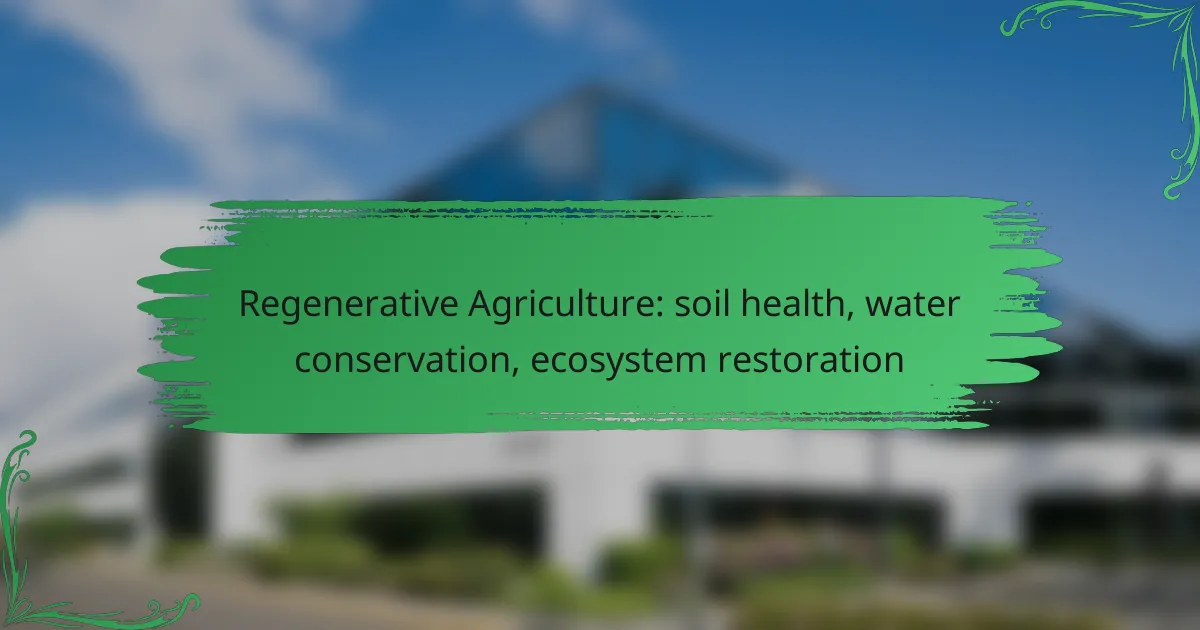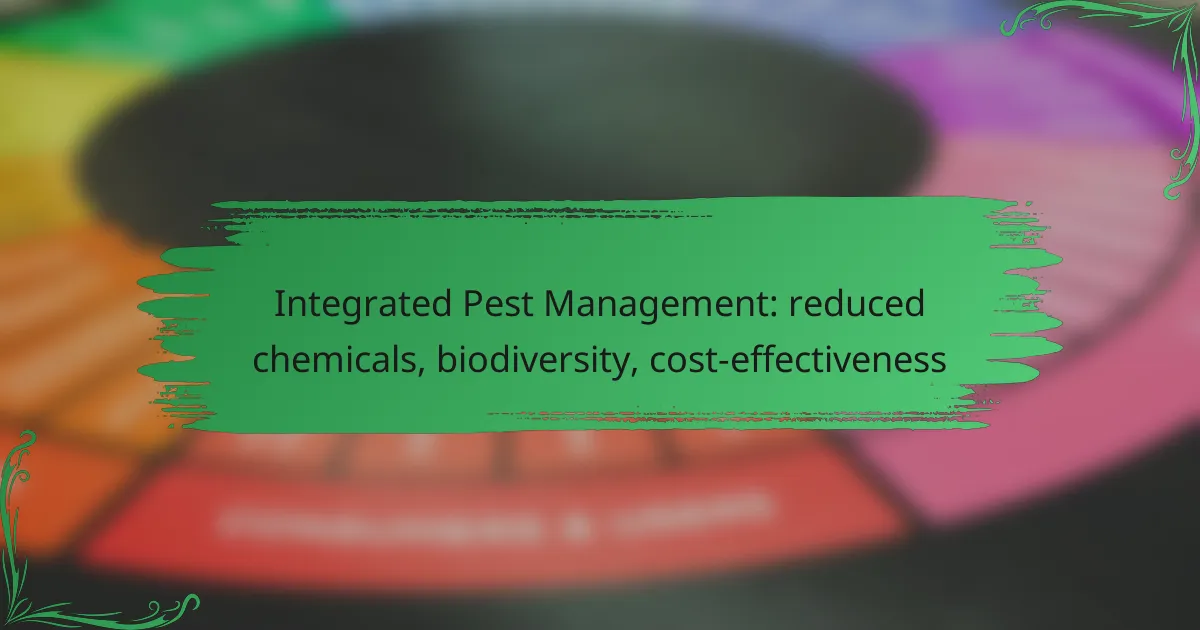Regenerative agriculture is a holistic approach that enhances soil health, promotes water conservation, and restores ecosystems. By focusing on practices that improve soil structure and foster microbial diversity, this method not only rejuvenates the land but also creates resilient ecosystems capable of withstanding environmental challenges.

How does regenerative agriculture improve soil health?
Regenerative agriculture enhances soil health by promoting practices that restore and maintain the natural ecosystem. This approach focuses on improving soil structure, increasing organic matter, and fostering microbial diversity, all of which contribute to healthier, more resilient soils.
Enhanced soil structure
Improving soil structure is crucial for enhancing soil health. Regenerative practices such as cover cropping and reduced tillage help create a stable soil structure, allowing for better water infiltration and root penetration. This leads to improved aeration and nutrient availability for plants.
Farmers can achieve enhanced soil structure by rotating crops and incorporating organic materials like compost. These methods can significantly reduce compaction and promote a more balanced soil ecosystem.
Increased organic matter
Increasing organic matter in the soil is essential for maintaining soil health. Organic matter, such as decomposed plant material, enhances soil fertility and moisture retention. Regenerative agriculture encourages practices like composting and mulching to boost organic content.
As organic matter increases, it can improve soil structure and support a diverse range of soil organisms. Aiming for organic matter levels of 3-5% can lead to noticeable improvements in soil quality and crop yields.
Microbial diversity
Microbial diversity is vital for a healthy soil ecosystem. Regenerative agriculture promotes practices that support a wide variety of soil microorganisms, which play essential roles in nutrient cycling and disease suppression. Techniques like crop rotation and reduced chemical inputs can enhance microbial diversity.
Farmers should consider using diverse cover crops to foster a rich microbial community. This diversity can lead to healthier plants and reduced reliance on synthetic fertilizers and pesticides.
Reduced erosion
Reducing soil erosion is a key benefit of regenerative agriculture. Practices such as cover cropping and contour farming help protect the soil surface from wind and water erosion. These methods maintain soil integrity and prevent the loss of valuable topsoil.
Implementing erosion control measures can lead to long-term sustainability and improved productivity. Farmers should monitor erosion-prone areas and apply appropriate techniques to mitigate risks effectively.
Carbon sequestration
Carbon sequestration is an important aspect of regenerative agriculture that improves soil health while addressing climate change. By increasing organic matter and enhancing soil structure, regenerative practices can capture and store carbon dioxide from the atmosphere in the soil.
Farmers can adopt practices like agroforestry and no-till farming to maximize carbon sequestration. This not only benefits the environment but can also enhance soil fertility, leading to more productive agricultural systems over time.

What practices promote water conservation in regenerative agriculture?
Water conservation in regenerative agriculture is achieved through various practices that enhance soil health and improve water retention. These methods not only reduce water usage but also promote sustainable farming by restoring ecosystems.
Cover cropping
Cover cropping involves planting specific crops during off-seasons to protect and enrich the soil. These crops help retain moisture, reduce erosion, and improve soil structure, which enhances water infiltration. Common cover crops include clover, rye, and vetch.
Farmers should select cover crops based on their local climate and soil conditions. A well-chosen cover crop can increase soil organic matter by a significant percentage, leading to better water retention and nutrient availability.
Reduced tillage
Reduced tillage minimizes soil disturbance, which helps maintain soil structure and moisture levels. By limiting tillage, farmers can preserve the natural habitat of beneficial organisms and enhance the soil’s ability to hold water. This practice can lead to improved crop yields over time.
Farmers should consider adopting no-till or minimum-till methods, which can reduce erosion and improve soil health. Implementing these practices may require new equipment and techniques, but the long-term benefits often outweigh the initial investment.
Water retention techniques
Water retention techniques, such as building swales or rain gardens, help capture and store rainwater for agricultural use. These structures slow down water runoff, allowing more water to infiltrate the soil and recharge groundwater supplies. They can be particularly effective in areas with irregular rainfall patterns.
Farmers can also implement mulch layers to reduce evaporation and improve moisture retention in the soil. Using organic materials like straw or wood chips can enhance soil fertility while conserving water.
Contour farming
Contour farming involves plowing and planting across the slope of the land rather than up and down. This practice creates natural barriers that slow water runoff and promote water infiltration, reducing soil erosion. It is especially beneficial on hilly terrain.
Farmers should assess their land’s topography to effectively implement contour farming. By aligning rows with the land’s contours, they can significantly improve water conservation and soil health, leading to more sustainable agricultural practices.

How does regenerative agriculture contribute to ecosystem restoration?
Regenerative agriculture plays a vital role in ecosystem restoration by enhancing soil health, improving water conservation, and fostering biodiversity. These practices not only rejuvenate the land but also create resilient ecosystems that can withstand environmental stresses.
Biodiversity enhancement
Regenerative agriculture promotes biodiversity by integrating diverse crop rotations and polycultures. This variety supports a wider range of organisms, from soil microbes to larger wildlife, which can improve ecosystem resilience and productivity. Farmers can implement cover crops and intercropping strategies to enhance biodiversity on their farms.
Incorporating native plants into agricultural systems can also attract beneficial insects and wildlife, further enriching the ecosystem. For instance, using legumes can improve soil nitrogen levels while providing habitat for various species.
Habitat restoration
Through practices like agroforestry and rewilding, regenerative agriculture can restore natural habitats that have been degraded by conventional farming. Planting trees and maintaining hedgerows can create corridors for wildlife, allowing species to thrive and migrate safely. This restoration is crucial for maintaining ecological balance.
Farmers can focus on restoring wetlands and riparian zones, which play essential roles in filtering water and providing habitat. These areas can significantly enhance local biodiversity while improving water quality and flood resilience.
Pollinator support
Regenerative agriculture supports pollinators by creating diverse and flowering habitats. By planting wildflowers and maintaining hedgerows, farmers can provide essential resources for bees, butterflies, and other pollinators. This is particularly important as many pollinator populations are declining due to habitat loss.
Implementing practices such as reduced pesticide use and organic farming can further protect these vital species. Farmers should consider timing their planting to ensure that flowering plants are available throughout the growing season, supporting pollinator health.
Natural pest control
Regenerative agriculture enhances natural pest control by fostering a balanced ecosystem where predators can thrive. By promoting biodiversity, farmers can attract beneficial insects such as ladybugs and lacewings that help manage pest populations naturally. This reduces the need for chemical pesticides.
Practices like crop rotation and companion planting can disrupt pest life cycles and minimize outbreaks. Farmers should monitor pest populations and encourage the presence of natural enemies to maintain a healthy balance in their fields.

What are the economic benefits of adopting regenerative agriculture?
Adopting regenerative agriculture can lead to significant economic benefits, including reduced costs, increased productivity, and access to higher-value markets. These advantages stem from improved soil health, efficient resource use, and enhanced ecosystem services.
Cost savings on inputs
Regenerative agriculture often results in lower input costs for farmers. By enhancing soil health through practices like cover cropping and reduced tillage, farmers can decrease their reliance on synthetic fertilizers and pesticides, which can be expensive.
For instance, farmers may find that healthy soils require fewer chemical inputs, leading to savings that can range from hundreds to thousands of dollars annually, depending on the scale of their operations. This reduction in spending can significantly improve profit margins.
Higher crop yields
Implementing regenerative practices can lead to higher crop yields over time. Healthier soils improve water retention and nutrient availability, which can enhance plant growth and resilience against pests and diseases.
Farmers may experience yield increases of 10-30% as soil quality improves, allowing them to produce more food per acre. This not only boosts income but also contributes to food security in local communities.
Access to premium markets
Regenerative agriculture can open doors to premium markets that prioritize sustainability. Consumers are increasingly willing to pay higher prices for products that are grown using environmentally friendly practices.
Farmers adopting regenerative methods may find opportunities in organic, local, or specialty markets, where prices can be significantly higher than conventional products. This access can lead to increased profitability and a stronger brand reputation.

What are the prerequisites for implementing regenerative agriculture?
Implementing regenerative agriculture requires a foundational understanding of soil health, water conservation, and ecosystem restoration. Key prerequisites include a commitment to sustainable practices, knowledge of local ecosystems, and access to resources that support regenerative techniques.
Understanding soil health
Soil health is crucial for regenerative agriculture as it affects crop productivity and ecosystem resilience. Healthy soil is rich in organic matter, has good structure, and supports diverse microbial life. Farmers should regularly test soil to assess its nutrient levels and microbial activity, aiming for balanced pH and organic content.
Practices such as cover cropping, reduced tillage, and compost application can enhance soil health. These methods improve nutrient cycling and increase water retention, which are essential for sustainable farming. Consider starting with small plots to test these practices before scaling up.
Water conservation techniques
Water conservation is vital in regenerative agriculture to ensure sustainable water use and ecosystem health. Techniques such as rainwater harvesting, drip irrigation, and mulching help retain moisture in the soil. Farmers should assess their water sources and implement systems that minimize waste and maximize efficiency.
In regions with variable rainfall, consider using drought-resistant crop varieties and soil amendments that improve water retention. Regular monitoring of soil moisture levels can guide irrigation practices and prevent overuse of water resources.
Ecosystem restoration practices
Ecosystem restoration involves rehabilitating degraded land to improve biodiversity and ecosystem services. This can include reforestation, wetland restoration, and creating wildlife habitats. Understanding local flora and fauna is essential for effective restoration efforts.
Engaging with local conservation groups can provide valuable insights and resources. Implementing buffer zones around agricultural fields can protect waterways and enhance habitat connectivity, supporting both agriculture and local wildlife.



